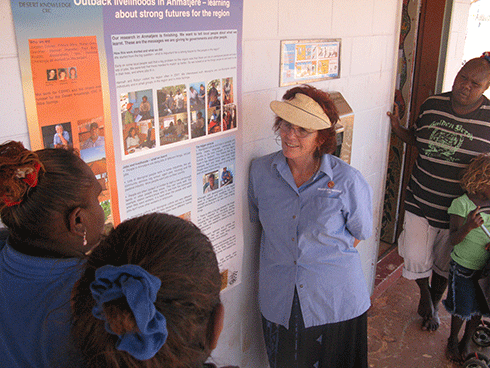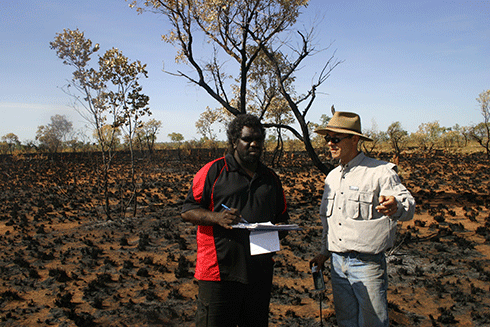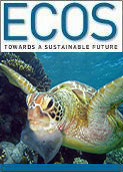
|
Published: 26 August 2013
Indigenous intellectual property and desert knowledge
In this second part of an ECOS interview with CSIRO researcher Dr Jocelyn Davies, Mike McRae asks about the ethical issues involved in engaging with other cultures, and how Australia’s desert heart might shape the nation’s future.

|
|
Jocelyn Davies during a meeting to get community feedback on research results from a Desert Knowledge CRC project, Anmatjere Region, Central Australia, December 2008. Credit: Jocelyn Davies
|
What measures are there to limit the risk of Indigenous intellectual property being taken and used inappropriately?
The mechanisms developed for [western] intellectual property management are fundamentally mismatched to the nature of Indigenous knowledge.
Indigenous knowledge has communal custodial elements, as well as encompassing elements that might have been developed or discovered by Indigenous individuals.
Laws and procedures for protection of intellectual property only readily provide for protection of the latter kinds of knowledge, through mechanisms such as copyright and patents. These are a poor fit to the nature of Indigenous knowledge and Indigenous people’s sense of custodianship and customary affiliation to, and ownership of, plants, animals, places, landscapes and cultural practices.
Commonly the protocols and frameworks developed to bridge this mismatch will refer to Indigenous cultural property, or cultural and intellectual property, since the definition of intellectual property is too narrow to be meaningful.
One unfortunate consequence of this poor fit is that Indigenous people can be fearful of engaging with research due to fears of knowledge appropriation.
Another unfortunate consequence is that Indigenous people can get unrealistic expectations that their knowledge, in itself, might have commercial value, whereas commercial value is only ever generated from knowledge when the knowledge is actually applied in some way. Partnerships are often important to develop uses of Indigenous knowledge that have market appeal.
All Australian research is underpinned by a requirement for free, prior, informed consent from people who participate in research. People who provide knowledge need to understand how that knowledge will be used and give consent to proposals to communicate that knowledge to others or apply it in other ways.
The onus here is on the researcher to propose a protocol that provides for good communication processes that will ensure Indigenous people’s consent is not subject to coercion and is well informed. Ethics committees constituted by universities and CSIRO operate to a national standard to review these proposed protocols and to hold researchers accountable to them.
There is much guidance available to researchers and ethics committees about managing ethical issues particular to Indigenous communities involved in research. However Indigenous communities may lack advice appropriate to their circumstances when they need to consider research proposals.
One strong effort to bridge that gap was by the former Desert Knowledge CRC (now the CRC for Remote Economic Participation), which engaged with the Aboriginal family well-being organisation, Waltja Tjutangku Palyapayi, to develop a community guide to research and research protocols for engaging Indigenous people and knowledge.
Another was the protocols developed by a group of senior women from several central Australian language groups for commercialisation of bush foods. Development of these protocols was facilitated by researchers and was again resourced through DK-CRC.
Protocols and efforts like these can’t stop the risk of unauthorised use of Indigenous knowledge, but they have been equipping Indigenous people to discriminate between research they want to be involved in and projects that have greater risks and whose benefit is less apparent.
Last year I had the experience of an Indigenous group saying ‘no’ when approached to be involved in research. I didn’t expect that outcome. It led to my research collaborators and I doing substantial extra work to re-scope the research proposal and develop a proposal to work with a different community.
Nevertheless I celebrate that group’s decision to say no, because it showed their confidence in engaging with us as researchers and indicates that our engagement processes truly were offering the group a free choice.
Most Australians would view the vast centre of our continent as less productive and therefore less valuable than its coastal fringes. What role do you see for desert ecosystems and their communities in Australia’s future?
It is less productive for agriculture, though the agriculture in remote Australia – mostly livestock grazing – nevertheless accounts for some 2 per cent of Australia’s gross domestic product.
And, with our recent national economic buoyancy riding on the back of a mining truck, Australians should be aware of the importance of remote regions as locations of some substantial mining operations.
Nearly 20 years ago, the Australian Rangeland Society, whose members have interests and expertise in remote Australia, challenged delegates at its biennial conference in Port Augusta to immerse themselves in four very different scenarios for how the country’s rangelands – those vast areas that are unsuitable for rain fed crop growing, generally because of low and variable rainfall – would be valued by Australians in 15 years time. There are elements of all scenarios playing out now in different regions.
In some regions, such as the Pilbara iron ore region and the Barkly tableland export-cattle-producing areas, the economy dominates the environment, with booms and busts driven by cycles of commodity prices and corporate investment.
In other regions – much of the South Australian station country comes to my mind – livestock grazing pressures, feral animals and weeds are well managed, and there are strong stewardship ethics and pride in producing quality food and fibre for niche high-value markets.
In yet other areas, conservation ethics dominate, and wellbeing comes from interaction with nature, community interaction, and creative activity inspired by the landscape and its people.
I am thinking particularly of the spinifex desert country, and the growing involvement of Aboriginal landowners in national efforts for biodiversity conservation, through Indigenous Protected Areas and the community ranger groups.
All three scenarios are recognisable in the very centre of Australia, around Alice Springs.
Overlying these trends, the relationship between desert ecosystems and communities seems to be heading towards the fourth scenario, where Australia looks outwards from the coast to other coasts and cities globally, and doesn’t often look back to its Centre.
There are certainly urban Australians who greatly value the vastness and the spaces, if only for a once-in-a-lifetime holiday, or shorter adventure trips to explore the 4WD tracks made by previous generations of mining explorers, drovers, military and aerospace testers, and Aboriginal people reclaiming their traditional country.
The demography that underpins the sentiments Australians have held about the Centre is changing markedly.
With each generation, fewer people have been brought up in rural Australia, in country towns or on farms. Most Australians will likely be less curious about or feel less attachment to the country beyond the coastal fringe.
It was this trend that inspired the movement to grow ‘desert knowledge’ – sharing and developing knowledge of how to live well, indeed thrive, in remote arid regions. This movement in turn has spawned many local initiatives in sustainable and smart living in Alice Springs, as well as research and advocacy for policies and initiatives that better match the dynamics of climate and economic opportunity in the Centre and that make it such an exciting place to live right now.
The first part of this interview with CSIRO’s Jocelyn Davies can be found here.




